Well done! You’ve made it to the last geeky blog in the sunscreen reboot.

I hope (by now) you are persuaded that the regular use of sunscreen protects against the effects of UVR over-exposure, namely skin cancer and photoaging.
I nor you, can wait till we are 40 to start using sunscreen and it is essential to use the RIGHT product.
This brings me to today’s blog, which is about identifying UV Filters on your sunscreen.
1) What are UV filters?
A UV filter is the workhorse of a sunscreen – its usually more than one ingredient that
exclusively or mainly (is) intended to protect the skin against certain UVR by absorbing, reflecting or scattering UVR;
UVA filters protect against UVA. UVB filters protect against UVB. UVA/UVB protect against UVR.
How do I know my product contains UVA and UVB filters?
With UVB filters its simply checking if your product has an SPF.
SPF tells you how much longer PROTECTED skin can be exposed to the lowest dose of UV before reddening (erythema) occurs. Erythema is caused by UVB and therefore SPF only gives information about UVB.
SPF is established by pretty much the same standard globally, so an SPF 30 in the EU is likely to be classified as an SPF 30 in the USA/Australia or India.
Also, I can be sure that my sunscreen contains some UVB filters if it has an SPF number.
The issue is always with UVA filters and determining if a product has UVA, depends on the region.
India: you have to read the Ingredient label. There is no guarantee that your product contains UVA filters.
USA: its optional for sunscreens to provide UVA protection. I look for “BROADSPECTRUM” on the label, as this is only permitted if the sunscreen has passed a Broadspectrum test (see this blog).
EU: all sunscreens MUST pass a critical wavelength test, that is the same as the American brodspectrum test above. Also, in addition, 1/3 of the SPF must be towards UVA protection.
On some products, you will find a UVA logo – but this is not mandatory.

In the EU, if you buy a sunscreen product, whether it is SPF 30 or SPF 50, the product will have passed a critical wavelength test and 1/3 of the SPF is UVA protection.
If you don’t care about the other potentially hazardous chemicals in your sunscreen, then honestly, your best bet is buying Made in EU sunscreens.
1) SEMI DEEP DIVE INTO EU FILTERS
The EU filters has 20+ permitted filters and the list is regularly updated at this link.
EU products ALL offer UVA protection that meets the broadspectrum test of the US AND in addition, one-third of SPF must be towards UVA protection.
This means that 1/3 of an SPF 30 or an SPF 50 product = UVA protection. This is NOT the case with American sunscreens, and the FDA recognises that (see link).
UVB filters
An SPF don’t have much to say about UVB filters because the whole entire point of an SPF rating is to ensure that the UVB filter does what is says it should. The problem is always trying to ensure that your product has enough UVA filters.
UVA filters
The EU has a bunch of UVA filters that the USA does not have. These are common UVA filters:
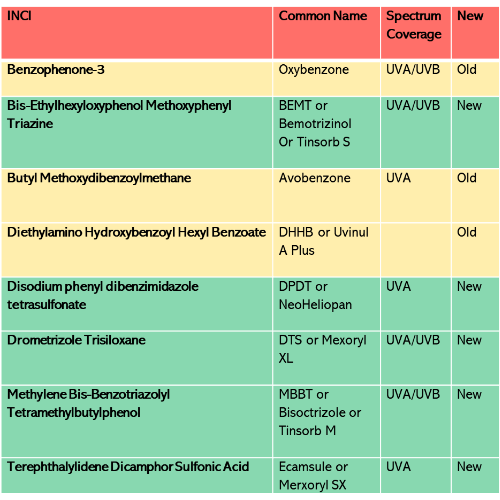
These NEW style filters:
- Provide superior UVA protection
- Are physically heavy molecules (see Diagram below), which makes dermal absorption astronomically difficult: all the problems Oxybenzone has are no longer relevant.
- The UVA filters are PHOTOSTABLE, which means fewer other photostabilisers or SPF boosters appear in your product.
Of course, none of these filters have the same UVA absorbance as Avobenzone, but honestly, I will take that.
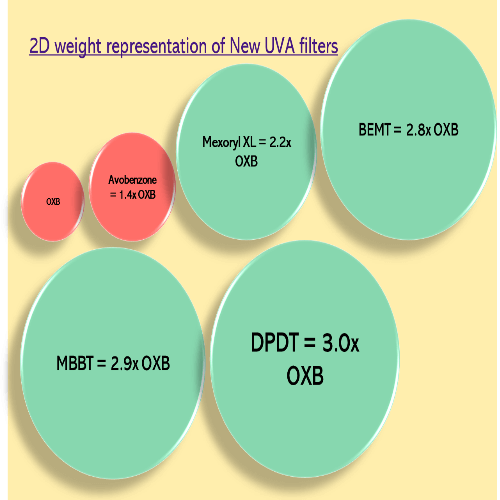
2) SEMI DEEP DIVE INTO AMERICAN FILTERS
a) What American filters are permitted?
In the USA, the filters that are currently permitted are Aminobenzoic acid (PABA), Avobenzone, Cinoxate, Dioxybenzone, Ensulizole, Homosalate, Meradimate, Octinoxate, Octisalate, Octocrylene, Oxybenzone, Padimate O, Sulisobenzone, Titanium dioxide, Trolamine salicylate, Zinc oxide.
You can find all these filters at this link. Recently the FDA said Aminobenzoic acid and Trolamine salicylate are not safe to use and I haven’t found them in the 140+ American sunscreens I have analysed.
b) What are the most common American filters used?
Based on my own review of 147 sunscreen products (sprays, lotions, sticks etc) from CVS pharmacy, these are the most common filters:
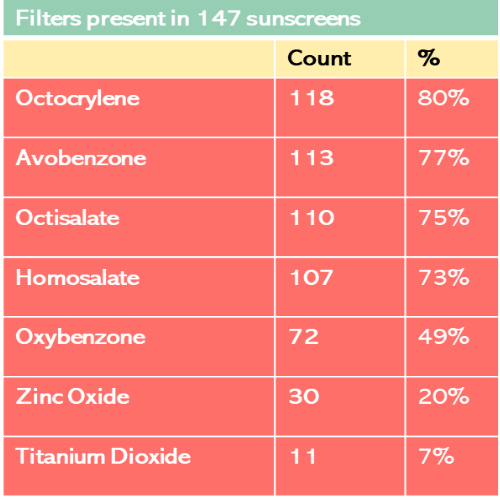
The UVB filters are Octocrylene, Octisalate and Homosalate. Octinoxate, a common UVB filter that all other countries use, is notably absent. There are only 2 UVA filters: Zinc Oxide or Avobenzone.
The following two graphs show the UVA absorbance of both Avobenzone and Zinc Oxide. As you can see the absorbance of Avobenzone is superior to Zinc Oxide, especially in the UVA1 region.
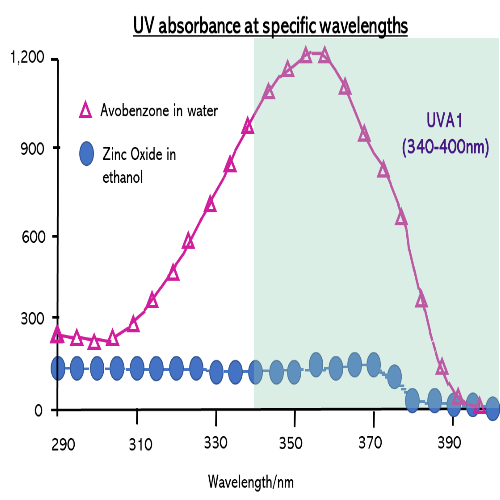
c) Can’t live with you Avobenzone and can’t live without you
Regular readers of my blog know that I love Zinc Oxide. Its safe to use, there is no dermal absorption and 21.6% Zinc Oxide products are broadspectrum (read this Zinc Oxide 101 for more info). In the US, Zinc Oxide cannot be combined with Avobenzone.
The problem with Avobenzone (and why I don’t like it) is its very PHOTOUNSTABLE* and to stabilise it, it is frequently combined with Oxybenzone, a hormone disruptor (see blog) This also means that US manufacturer’s steer away from superior UVB filter, Octinoxate.
(*On Avobenzone, the FDA says,” Avobenzone’s) efficacy decreases by 50%-90% after 60 minutes of exposure to sunlight.” So, the one job that Avobenzone is good at – UVA absorbance – is also its Achilles heel.)
d) Nanoparticles in sunscreens
American regulators do not require disclosure on sunscreen products of (e.g.) nano Zinc Oxide or nano Titanium Dioxide used. Surveys show that NP are used in American sunscreen (read this blog for more info).
d) Closing remarks
I look for BROADSPECTRUM on labels of American sunscreens. In all likelihood, your product will be Zinc Oxide or Avobenzone based.
Finally, note that “broadspectrum” in the USA can offer inferior protection to the EU method of 1/3 of SPF=UVA protection (read this blog for more info).
Quick note on EU labelling requirements
(see also Do you understand the gibberish on sunscreen labels?)
- Use of nano forms of Zinc Oxide and Titanium Dioxide must be disclosed on packaging. (I’ve seen this as Zinc Oxide (nano)
- If Oxybenzone (or Benzophenone-3) is used in sunscreens, then you’ll find “Contains Benzophenone-3.” (I don’t tend to see Oxybenzone in European sunscreens, and perhaps this is why).
- “Broadspectrum” is not a labelling category in the EU. You will not see it.
- Efficacy of sun protection is simplified to “low”, “medium”, “high”, “very high.”
- “Low protection” or SPF 6/SPF 10
- “Medium protection” or SPF 15 /SPF 20/ SPF 25
- “High protection” or SPF 30/ SPF 50
- “Very High protection” or SPF 50+
- All Made in EU products that are sold in the EU will provide minimal UVA protection as I have described. It is not compulsory to carry a UVA logo.
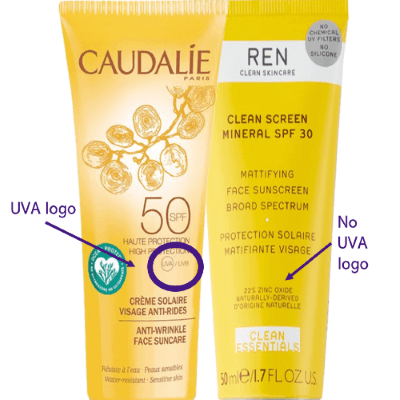
What can we do as consumers to get the best UVA protection?
Its critical to LOOK for UVA filters on your product. Don’t just rely on manufacturers – especially in India and the USA. (see also How to buy sunscreen: the UVA cut)
Secondly, do not make it a habit to buy Very High SPF products, by which I mean SPF over SPF 50+.
The International Agency for Research on Cancer has found that high SPF sunscreen products are associated with longer intentional UV exposures, raising the concern that use of these products may result in significant doses of UVA radiation
Also, in the US and India, there is a real risk that the high SPF product you buy does not have a correspondingly high increase in UVA protection.
Therefore, higher SPF products can increases the risk of skin cancer and accelerates photoaging.
SPF50+ should be the absolute maximum that you should use.
A quick word on India
I would like to point out that India has copied the EU list on permitted filters almost verbatim. (Make of that what you will). There are no specific rules on labelling, mandatory requirements for UVA and UVB…ya, what is the point.
Sources and Uses
UV-A PROTECTION AND SUNSCREENS CIE Technical Report ISBN 978 3 901 906 80 0;
COMMISSION RECOMMENDATION of 22 September 2006 on the efficacy of sunscreen products and the claims made relating thereto (notified under document number C(2006) 4089) (Text with EEA relevance) (2006/647/EC):
Guidelines to Commission Regulation (EU) No 655/2013 laying down common criteria for the justification of claims used in relation to cosmetic products Ref. Ares(2015)4340493 – 16/10/2015;
Frank Padera, PerkinElmer, Inc. Shelton, CT Sunscreen Testing According to COLIPA 2011/FDA Final Rule 2011 Using UV/Vis LAMBDA Spectrophotometers
Steven Q. Wang • Henry W. Lim Editors, Principles and Practice of Photoprotection ISBN 978-3-319-29381-3
Sunscreen Drug Products for Over-the-Counter Human Use, A Proposed Rule by the Food and Drug Administration on 02/26/2019
Skin Cancer Facts & Statistics https://www.skincancer.org/skin-cancer-information/skin-cancer-facts/
The Austrian UVA-Network. Photochem Photobiol. 2019 Apr 24. doi: 10.1111/php.13111 https://www.ncbi.nlm.nih.gov/pubmed/31017671
Annex VI, Last update: 05/08/2019, LIST OF UV FILTERS ALLOWED IN COSMETIC PRODUCTS ; https://ec.europa.eu/growth/tools-databases/cosing/pdf/COSING_Annex%20VI_v2.pdf
Krutmann J, Bouloc A et al, The skin aging exposome Journal of Dermatological Science 85 (2017) 152–161 http://dx.doi.org/10.1016/j.jdermsci.2016.09.015
Autier, P., M. Boniol, and J.F. Dore, “Sunscreen Use and Increased Duration of Intentional Sun Exposure: Still a Burning Issue,” International Journal of Cancer, vol. 121(1), pp. 1-5, 2007.
